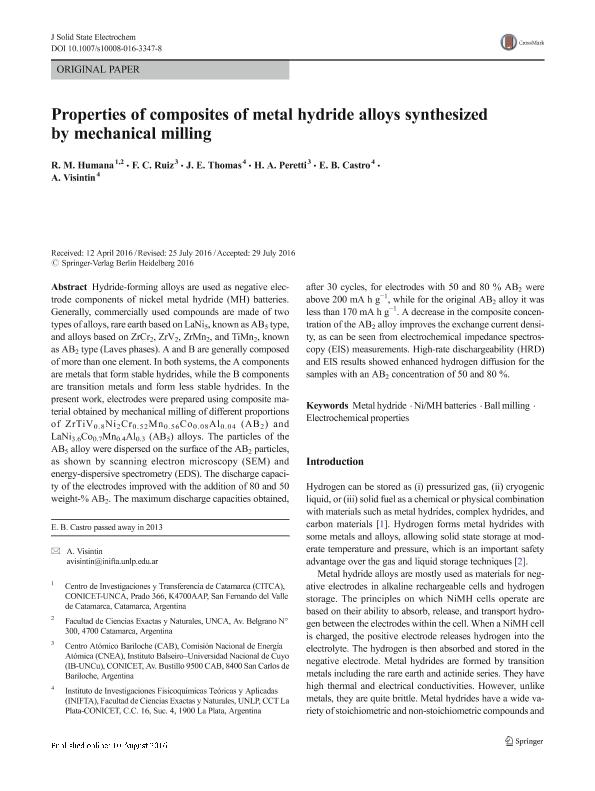Mostrar el registro sencillo del ítem
dc.contributor.author
Humana, Rita Mariangeles

dc.contributor.author
Ruiz, Fabricio Carlos

dc.contributor.author
Thomas, Jorge Enrique

dc.contributor.author
Peretti Hollemaert, Hernán Américo

dc.contributor.author
Castro, Elida Beatriz

dc.contributor.author
Visintin, Arnaldo

dc.date.available
2018-07-25T16:53:59Z
dc.date.issued
2017-01
dc.identifier.citation
Humana, Rita Mariangeles; Ruiz, Fabricio Carlos; Thomas, Jorge Enrique; Peretti Hollemaert, Hernán Américo; Castro, Elida Beatriz; et al.; Properties of composites of metal hydride alloys synthesized by mechanical milling; Springer; Journal of Solid State Electrochemistry (print); 21; 1; 1-2017; 153-160
dc.identifier.issn
1432-8488
dc.identifier.uri
http://hdl.handle.net/11336/53083
dc.description.abstract
Hydride-forming alloys are used as negative electrode components of nickel metal hydride (MH) batteries. Generally, commercially used compounds are made of two types of alloys, rare earth based on LaNi5, known as AB5 type, and alloys based on ZrCr2, ZrV2, ZrMn2, and TiMn2, known as AB2 type (Laves phases). A and B are generally composed of more than one element. In both systems, the A components are metals that form stable hydrides, while the B components are transition metals and form less stable hydrides. In the present work, electrodes were prepared using composite material obtained by mechanical milling of different proportions of ZrTiV0.8Ni2Cr0.52Mn0.56Co0.08Al0.04 (AB2) and LaNi3.6Co0.7Mn0.4Al0.3 (AB5) alloys. The particles of the AB5 alloy were dispersed on the surface of the AB2 particles, as shown by scanning electron microscopy (SEM) and energy-dispersive spectrometry (EDS). The discharge capacity of the electrodes improved with the addition of 80 and 50 weight-% AB2. The maximum discharge capacities obtained, after 30 cycles, for electrodes with 50 and 80 % AB2 were above 200 mA h g−1, while for the original AB2 alloy it was less than 170 mA h g−1. A decrease in the composite concentration of the AB2 alloy improves the exchange current density, as can be seen from electrochemical impedance spectroscopy (EIS) measurements. High-rate dischargeability (HRD) and EIS results showed enhanced hydrogen diffusion for the samples with an AB2 concentration of 50 and 80 %.
dc.format
application/pdf
dc.language.iso
eng
dc.publisher
Springer

dc.rights
info:eu-repo/semantics/openAccess
dc.rights.uri
https://creativecommons.org/licenses/by-nc-sa/2.5/ar/
dc.subject
BALL MILLING
dc.subject
ELECTROCHEMICAL PROPERTIES
dc.subject
METAL HYDRIDE
dc.subject
NI/MH BATTERIES
dc.subject.classification
Otras Ciencias Químicas

dc.subject.classification
Ciencias Químicas

dc.subject.classification
CIENCIAS NATURALES Y EXACTAS

dc.title
Properties of composites of metal hydride alloys synthesized by mechanical milling
dc.type
info:eu-repo/semantics/article
dc.type
info:ar-repo/semantics/artículo
dc.type
info:eu-repo/semantics/publishedVersion
dc.date.updated
2018-07-25T13:52:07Z
dc.journal.volume
21
dc.journal.number
1
dc.journal.pagination
153-160
dc.journal.pais
Alemania

dc.journal.ciudad
Berlin
dc.description.fil
Fil: Humana, Rita Mariangeles. Consejo Nacional de Investigaciones Científicas y Técnicas. Centro de Investigaciones y Transferencia de Catamarca. Universidad Nacional de Catamarca. Centro de Investigaciones y Transferencia de Catamarca; Argentina. Universidad Nacional de Catamarca. Facultad de Ciencias Exactas y Naturales; Argentina
dc.description.fil
Fil: Ruiz, Fabricio Carlos. Consejo Nacional de Investigaciones Científicas y Técnicas; Argentina. Comisión Nacional de Energía Atómica. Centro Atómico Bariloche; Argentina. Comisión Nacional de Energía Atómica. Gerencia del Área de Energía Nuclear. Instituto Balseiro; Argentina. Universidad Nacional de Cuyo; Argentina
dc.description.fil
Fil: Thomas, Jorge Enrique. Consejo Nacional de Investigaciones Científicas y Técnicas. Centro Científico Tecnológico Conicet - La Plata. Instituto de Investigaciones Fisicoquímicas Teóricas y Aplicadas. Universidad Nacional de La Plata. Facultad de Ciencias Exactas. Instituto de Investigaciones Fisicoquímicas Teóricas y Aplicadas; Argentina
dc.description.fil
Fil: Peretti Hollemaert, Hernán Américo. Consejo Nacional de Investigaciones Científicas y Técnicas; Argentina. Comisión Nacional de Energía Atómica. Centro Atómico Bariloche; Argentina. Comisión Nacional de Energía Atómica. Gerencia del Área de Energía Nuclear. Instituto Balseiro; Argentina. Universidad Nacional de Cuyo; Argentina
dc.description.fil
Fil: Castro, Elida Beatriz. Consejo Nacional de Investigaciones Científicas y Técnicas. Centro Científico Tecnológico Conicet - La Plata. Instituto de Investigaciones Fisicoquímicas Teóricas y Aplicadas. Universidad Nacional de La Plata. Facultad de Ciencias Exactas. Instituto de Investigaciones Fisicoquímicas Teóricas y Aplicadas; Argentina
dc.description.fil
Fil: Visintin, Arnaldo. Consejo Nacional de Investigaciones Científicas y Técnicas. Centro Científico Tecnológico Conicet - La Plata. Instituto de Investigaciones Fisicoquímicas Teóricas y Aplicadas. Universidad Nacional de La Plata. Facultad de Ciencias Exactas. Instituto de Investigaciones Fisicoquímicas Teóricas y Aplicadas; Argentina
dc.journal.title
Journal of Solid State Electrochemistry (print)

dc.relation.alternativeid
info:eu-repo/semantics/altIdentifier/doi/https://dx.doi.org/10.1007/s10008-016-3347-8
dc.relation.alternativeid
info:eu-repo/semantics/altIdentifier/url/https://link.springer.com/article/10.1007%2Fs10008-016-3347-8
Archivos asociados
